
( a small introduction )
To start with, I will provide a brief
introductory remark on Riding the Storm
- an instruction, which deals with the
subject of restistance.
The very act of designing and writing
this introductory text should be seen as
a small act of resistance. As a
resistance against the normalisation and
standardisation of thoughts and their
mediation. A small act of resistance
against the dominance of scientific and
academic texts. Scientific and academic
texts are texts in which a specific
question is systematically analysed and
answered. The texts must be produced in
a methodically controlled manner in
order to make the process of gaining
knowledge comprehensible to third
parties and thus criticisable (or
falsifiable). However, features such as
a uniform structure of the text (i.e.
introduction, main body and conclusion
or the referencing system) play a major
role.
Clearly, a certain order in the
structure of an essay makes sense if
something has to be compared with - or
against - each other. But can I compare
abstract concepts such as the
ideas/definitions/interpretations of
resistance with each other? Are these
different
ideas/definitions/interpretations of
resistance not each independent and
context-dependent constructs of function
and legitimisation?
It is also very clear: intellectual
property must remain protected. And you
must not adorn yourself with other
people's feathers.
But nothing is original.
And knowledge - that is a constant
linking.
Knowledge is not a reflection, but a
concatenation, a rhizome - according to
Gilles Deleuze and Félix Guattari in
their writings (1980).
Why a website?
It is precisely this rhizome-like
quality that I find in the handling of
webpages. Here it is possible to
interrupt a continuous text again and
again and to link it with other text
passages using hyperlinks.
Things and facts are no longer placed in
relation to each other by sequencing (as
in a continuous text) (which already
demands an initial explanation and thus
entails an initial interpretation:
because which information comes before
another and why). This rhizome-like
placement of information also means that
these fragments of information (things
and facts) are no longer limited to one
meaning (caused by hierarchical order).
Clicking freely through texts can (if
you are willing to remain alert and open
while reading) lead to unexpected "aha"
experiences.
In this respect, knowledge is created by
the reader or viewer. My intention in
this work is to deal creatively with
fragments of information and to present
these fragments as fragments.
So it has become a work about the theme
resistance that shows what I was looking
for and what new connections have
emerged from it.
